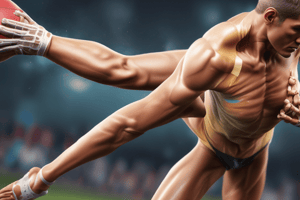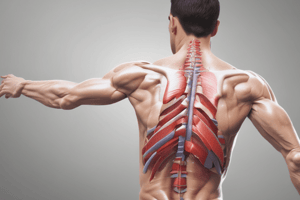Podcast
Questions and Answers
What is the most common direction for shoulder dislocation?
What is the most common direction for shoulder dislocation?
- Multidirectional
- Anterior (correct)
- Posterior
- Inferior
Which symptom is most commonly associated with a capsule/ligament tear?
Which symptom is most commonly associated with a capsule/ligament tear?
- Numbness in the arm
- Decreased range of motion
- Severe swelling
- Point tenderness (correct)
Which of the following is NOT a recommended treatment method for shoulder dislocation?
Which of the following is NOT a recommended treatment method for shoulder dislocation?
- RICE
- Taping
- Surgery at all times (correct)
- Loading bearing exercises after pain resolves
What is indicated by a positive result in the Apprehension (crank) Test?
What is indicated by a positive result in the Apprehension (crank) Test?
Which stage of Adhesive Capsulitis is characterized by severe pain and limitation of range of motion?
Which stage of Adhesive Capsulitis is characterized by severe pain and limitation of range of motion?
Which symptom is NOT typically associated with a rotator cuff injury?
Which symptom is NOT typically associated with a rotator cuff injury?
What is the most common injury in rotator cuff tears?
What is the most common injury in rotator cuff tears?
Which factor does NOT contribute to impingement syndrome?
Which factor does NOT contribute to impingement syndrome?
Which special test evaluates the integrity of the supraspinatus?
Which special test evaluates the integrity of the supraspinatus?
What primarily causes bursa pathologies?
What primarily causes bursa pathologies?
What is the primary function of the humeroulnar joint?
What is the primary function of the humeroulnar joint?
Which structure articulates with the trochlea of the humerus?
Which structure articulates with the trochlea of the humerus?
How does the radial head function during forearm rotation?
How does the radial head function during forearm rotation?
Which of the following is NOT a part of the elbow joint structure?
Which of the following is NOT a part of the elbow joint structure?
What movement does the humeroradial joint primarily facilitate?
What movement does the humeroradial joint primarily facilitate?
What is likely to happen to ligaments when they experience a Grade III tear?
What is likely to happen to ligaments when they experience a Grade III tear?
Which of the following is a common example of shoulder pathology?
Which of the following is a common example of shoulder pathology?
What is considered a key feature of osteoarthritis?
What is considered a key feature of osteoarthritis?
What is the primary function of the scapula within the shoulder complex?
What is the primary function of the scapula within the shoulder complex?
What is the primary risk associated with a fractured clavicle?
What is the primary risk associated with a fractured clavicle?
Which assessment focus is essential for occupational therapists when evaluating a client?
Which assessment focus is essential for occupational therapists when evaluating a client?
Which joint serves as the only bony attachment point for the upper limb?
Which joint serves as the only bony attachment point for the upper limb?
What is the scapulohumeral rhythm during arm abduction?
What is the scapulohumeral rhythm during arm abduction?
What does a sulcus sign typically indicate?
What does a sulcus sign typically indicate?
How does a Grade II ligament tear present?
How does a Grade II ligament tear present?
What stabilizes the glenohumeral joint primarily?
What stabilizes the glenohumeral joint primarily?
What is one of the roles of the acromioclavicular joint?
What is one of the roles of the acromioclavicular joint?
What is a primary function of the shoulder joint that can be impaired by capsular pathology?
What is a primary function of the shoulder joint that can be impaired by capsular pathology?
Which muscle is responsible for internal rotation of the shoulder?
Which muscle is responsible for internal rotation of the shoulder?
During passive movements assessment, what is observed?
During passive movements assessment, what is observed?
Which condition might indicate a lack of spontaneous movement during an observation assessment?
Which condition might indicate a lack of spontaneous movement during an observation assessment?
What is the typical carrying angle in males?
What is the typical carrying angle in males?
What angulation of the elbow is characterized by positioning the forearm closer to the body?
What angulation of the elbow is characterized by positioning the forearm closer to the body?
Which ligament wraps around the radial head and holds it in position?
Which ligament wraps around the radial head and holds it in position?
What is a common mechanism of injury (MOI) for a radial head fracture?
What is a common mechanism of injury (MOI) for a radial head fracture?
What condition results from a malunion of the supracondylar humeral fracture?
What condition results from a malunion of the supracondylar humeral fracture?
Which of the following describes the pain associated with lateral epicondylitis?
Which of the following describes the pain associated with lateral epicondylitis?
What is the typical age of children who experience radial head subluxation (Nursemaid’s elbow)?
What is the typical age of children who experience radial head subluxation (Nursemaid’s elbow)?
Which muscle is NOT classified as a flexor of the elbow?
Which muscle is NOT classified as a flexor of the elbow?
Flashcards
Shoulder Osteology
Shoulder Osteology
The bony structures that make up the shoulder, including the scapula, humerus, and clavicle.
Glenoid Fossa
Glenoid Fossa
A shallow socket on the scapula that articulates with the head of the humerus.
Scapulothoracic Joint
Scapulothoracic Joint
The joint where the scapula articulates with the ribcage, allowing for a variety of movements.
Sternoclavicular Joint
Sternoclavicular Joint
Signup and view all the flashcards
Acromioclavicular Joint
Acromioclavicular Joint
Signup and view all the flashcards
Glenohumeral Joint
Glenohumeral Joint
Signup and view all the flashcards
Rotator Cuff Muscles
Rotator Cuff Muscles
Signup and view all the flashcards
Scapulohumeral Rhythm
Scapulohumeral Rhythm
Signup and view all the flashcards
Sulcus sign
Sulcus sign
Signup and view all the flashcards
Winging
Winging
Signup and view all the flashcards
Functional assessment
Functional assessment
Signup and view all the flashcards
Adhesive capsulitis
Adhesive capsulitis
Signup and view all the flashcards
Shoulder impingement
Shoulder impingement
Signup and view all the flashcards
Clavicle fracture
Clavicle fracture
Signup and view all the flashcards
Osteoarthritis
Osteoarthritis
Signup and view all the flashcards
Capsule pathology/Ligament tear
Capsule pathology/Ligament tear
Signup and view all the flashcards
Shoulder Dislocation
Shoulder Dislocation
Signup and view all the flashcards
Shoulder Separation
Shoulder Separation
Signup and view all the flashcards
Relocation (Fowler) Test
Relocation (Fowler) Test
Signup and view all the flashcards
Adhesive Capsulitis (Frozen Shoulder)
Adhesive Capsulitis (Frozen Shoulder)
Signup and view all the flashcards
Painful Stage of Adhesive Capsulitis
Painful Stage of Adhesive Capsulitis
Signup and view all the flashcards
Humeroulnar Joint
Humeroulnar Joint
Signup and view all the flashcards
Humeroradial Joint
Humeroradial Joint
Signup and view all the flashcards
Proximal Radioulnar Joint
Proximal Radioulnar Joint
Signup and view all the flashcards
Trochlear Notch
Trochlear Notch
Signup and view all the flashcards
Olecranon Process
Olecranon Process
Signup and view all the flashcards
Thawing
Thawing
Signup and view all the flashcards
Impingement
Impingement
Signup and view all the flashcards
Drop Test
Drop Test
Signup and view all the flashcards
Neer Impingement Test
Neer Impingement Test
Signup and view all the flashcards
Winging Scapula
Winging Scapula
Signup and view all the flashcards
Annular Ligament
Annular Ligament
Signup and view all the flashcards
Carrying Angle
Carrying Angle
Signup and view all the flashcards
Cubitus Varus
Cubitus Varus
Signup and view all the flashcards
Cubitus Valgus
Cubitus Valgus
Signup and view all the flashcards
Lateral Epicondylitis (Tennis Elbow)
Lateral Epicondylitis (Tennis Elbow)
Signup and view all the flashcards
Medial Epicondylitis (Golfer's Elbow)
Medial Epicondylitis (Golfer's Elbow)
Signup and view all the flashcards
Radial Head Subluxation (Nursemaid's Elbow)
Radial Head Subluxation (Nursemaid's Elbow)
Signup and view all the flashcards
Gunstock Deformity
Gunstock Deformity
Signup and view all the flashcards
Study Notes
Shoulder Anatomy
- The shoulder complex includes the anatomy, osteology, joints, musculature, innervation, assessment, and pathology.
- Three bones make up the shoulder: scapula, humerus, and clavicle.
Shoulder Anatomy - Osteology
- The scapula positions the glenoid fossa for humeral motion.
- It has a superior angle, medial (vertebral) border, inferior angle, and lateral (axillary) border.
- The scapula's position is vital for humeral movement.
- The clavicle positions the humerus laterally away from the upper body.
- It has an acromial end, anterior side, posterior side, sternal end.
- The clavicle's position is critical to preventing the humerus from moving away from the body too much and supports/positions the arm away from the body.
- The humerus has a greater tubercle, crest of greater tubercle, head of the humerus, neck, lesser tubercle, Intertubercular groove, surgical neck, deltoid tuberosity.
- These features are important as they form articular surfaces for muscles and other bones.
Shoulder Complex - 4 Joints
- The scapulothoracic joint is the articulation between the scapula and the thorax.
- It facilitates movement across the ribcage.
- The sternoclavicular joint connects the clavicle to the sternum.
- It enables mobility of the arms/shoulder.
- The acromioclavicular joint joins the clavicle to the scapula.
- It assists in the full abduction of arm movement.
- The glenohumeral joint connects the humerus and the glenoid fossa of the scapula.
- It enables the wide range of shoulder movement.
Scapulothoracic Joint
- Articulates with the rib cage.
- Spans ribs 2-7
- It has six motions: elevation and depression, protraction, retraction, upward and downward rotation.
- Motions are critical to shoulder movement.
Sternoclavicular Joint
- The only bony connection between the upper limb and the axial skeleton.
- A disc is present between the articulating surfaces which provides stability.
Acromioclavicular Joint
- Augments the range of motion (ROM) of the humerus.
- It has a fibrous capsule surrounding the joint and contains an articular disc.
- It aids in full arm abduction up to 180°.
Glenohumeral Joint
- Depends on muscles (rather than bones/ligaments) for support.
- The labrum deepens the glenoid fossa.
- Its placement is critical for full abduction of the shoulder.
Shoulder Complex – Muscles
- Numerous muscles surround the shoulder.
- They are critical to shoulder and upper body movement.
- Examples: deltoid, pectoralis major, latissimus dorsi, serratus anterior, biceps brachii, triceps brachii, etc.
Shoulder Complex – Actions
- Tables detailing muscles and actions they perform.
- For example, the anterior deltoid performs flexion and abduction/horizontal adduction.
Shoulder Complex – Nerve Supply
- Tabular data on nerve supply to various muscles in the shoulder region.
Rotator Cuff
- Includes supraspinatus (abduction), infraspinatus (ER), teres minor (ER), and subscapularis (IR) muscles.
- Essential for glenohumeral joint function.
Scapulohumeral Rhythm
- 2:1 ratio of scapular and humeral movement during abduction.
- The clavicle plays a vital role in this movement.
- Without it, abduction might only be possible to 120°.
Reverse Scapulohumeral Rhythm
- In reverse rhythm, the scapula moves more than the humerus.
- This is a crucial part of initial shoulder movement.
Assessment
- Assessment involves observing the shoulder, active/passive movement, strength testing, functional assessment, and specific tests.
Observations
- Observations include natural alignment of body parts, spontaneous movement & function.
- Lack of movement, guarding, or bracing as well as skin condition and deformity.
Functional Assessment
- OTs use scales to assess function based on what clients need/want to do.
- Examples are self-care, productivity, and leisure.
Shoulder Pathology - Examples
- This section shows different examples of shoulder pathologies.
- Examples include bone fractures, capsule tears, ligament injuries, adhesive capsulitis, nerve damage, and more.
Fracture
- Clavicle fractures often require a figure of 8 brace.
- Humerus fractures can be impacted neck (stable) or shaft (may heal on its own).
- Gravity can affect fracture reduction.
- Surgery (ORIF) may be necessary.
Osteoarthritis
- Cartilage wears away, causing bone degeneration.
- Leads to bone remodelling.
- Pain and stiffness occur.
- Activity decreases.
Capsule Pathology/Ligament Tear
- Common after traumatic events and can range from mild stretching to complete tears resulting in instability to the shoulder(subluxation/dislocation).
- Dislocations can be in many directions, most commonly anterior/posterior.
Capsule/Ligament Tear - Treatment
- Treatment includes RICE (rest, ice, compression, elevation), movement within pain-free ranges, taping, and exercises.
- Further treatment may be required if the injury is more serious..
Shoulder Separation
- A disruption of the acromioclavicular joint.
- Pain is a common symptom. Deformity also occurs.
Dislocation & Subluxation
- Displacement of the humeral head, often anterior.
- Treatment involves immobilization.
- Damage to the labrum and increased instability is possible.
- More common in persons over age 30
Special Tests: Anterior Instability
- Tests to assess for anterior instability of the shoulder include the apprehension, relocation, and load shift tests.
Special Tests: Inferior Instability
- Tests involve assessment.
- This section describes specific tests to evaluate for inferior shoulder instability, such as the sulcus sign.
Adhesive Capsulitis
- Also known as frozen shoulder.
- Characterized by a thickening of the shoulder capsule.
- Common in women age 40-60.
- May occur after prolonged immobilization.
- Often self-limiting but hydrodilatation is an option in prolonged cases.
- The disease includes four stages: Painful, Freezing, Frozen, and Thawing.
- Stages 1-3 involves increasingly severe symptoms, stiffness or pain in the freezing or frozen stages.
- Stage 4 has gradual improvement in movement and decreased pain.
Rotator Cuff Injury
- Can be acute or chronic.
- More prevalent in persons > 60 but happens to younger people.
- Repetitive overhead activities and forceful loading can cause issues, commonly impacting the supraspinatus or other rotator cuff muscles.
Rotator Cuff Painful Arc
- Presents with pain, weakness, decreased ROM, clicking, catching, and stiffness.
Impingement
- Impingement involves soft tissue (e.g., rotator cuff, bursa, tendon) pinched or impinged under the acromion during overhead activities.
- Often presents with pain in the shoulder, arm, and/or possible into the forearm
- Impingement can be caused by many factors, including structural abnormalities, inflammation, or shoulder instability.
Special Tests: Impingement
- Tests for impingement such as the Neer test assess for pain with the test.
Special Tests: Muscle or Tendon
- Specific tests for evaluating supraspinatus, empty can test, or drop test are critical to the testing procedure.
Bursa Pathologies
- Bursas are shock absorbers.
- Inflammation, rupture, or deterioration can occur, often due to overuse or impingement
Winging Scapula
- Weakness in rhomboids, long thoracic nerve (serratus), or the nerve to the trapezius.
- A scapula that protrudes when testing for winging.
Elbow Anatomy
- Elbow anatomy includes osteology, joints, musculature, innervation, assessment, and pathology.
Elbow - Muscles
- Flexors include biceps brachii, brachialis, and brachioradialis.
- Extensors include triceps brachii, and anconeus.
Elbow & Forearm - Actions
- Tabular of the various actions performed by these muscles.
Elbow & Forearm - Nerves
- Provides a table of nerves supplying the elbow and forearm.
Assessment - Observations
- Evaluation includes observation of the carrying angle.
- Men typically have 5-10 degree carrying angle, women typically have 10-15.
- Cubitus Valgus is above 15 degrees and can be observed on extension of the elbow.
- Cubitus varus is less than 5-10 degrees.
Fracture
- Supracondylar humeral fractures, aka gunstock deformity, result in varus angulation.
- Common injuries include radial head fractures with MOI (mechanism of injury) often due to FOOSH (fall on outstretched hand).
- Pain, tenderness, and limited movement of arm or elbow often accompanies this injury.
- Treatment may include immobilization and potentially surgery (ORIF).
Dislocation/Subluxation
- Radial head subluxation, also known as nursemaid's elbow.
- Can occur in toddlers due to a sudden traction force on the forearm.
- Adults injuries might have a wider radial head, potentially causing issues with the ligaments.
Lateral Epicondylitis
- Also called tennis elbow.
- It affects the common extensor tendon origin at the lateral epicondyle of the humerus.
- It typically occurs from repetitive wrist extension/activities
- Can present as dull ache at rest or sharp pain with activity
Medial Epicondylitis
- Also known as golfer's elbow.
- It affects the wrist flexor tendon origin at the medial epicondyle of the humerus.
- It typically occurs from repetitive wrist flexion/activities
- Can present with elbow pain or weakness with twisting, grabbing things, or lifting.
Pronator Teres Syndrome
- Median nerve compression by pronator teres.
- Can cause paresthesia (numbness) in the thumb, index, and/or middle finger
- Typically aggravated by activity causing possible pain on the volar surface of the forearm.
Cubital Tunnel Syndrome
- Ulnar nerve compression at the elbow called cubital tunnel.
- Causes are many and can include the position of the arm during movement/activity, repeated pressure on the forearm leading to pain and numbness in the ring and small finger.
Ulnar Collateral Ligament Pathology
- Inflammation, stretching, or tearing of the ulnar collateral ligament.
- Common in activities such as baseball pitching.
- Pain/Instability are common.
Special Tests – Neuro Dysfunction
- Section describing various neurological tests (e.g., Tinel's sign, pronator teres tests, etc.).
Special Tests – Epicondylitis
- Section describing specific tests for various epicondylitis conditions (e.g., Lateral/medial).
OT Interventions
- Includes education, donning and doffing assistance, exercises (e.g., pendular).
- Can also include ADLS which addresses daily living tasks.
Studying That Suits You
Use AI to generate personalized quizzes and flashcards to suit your learning preferences.




